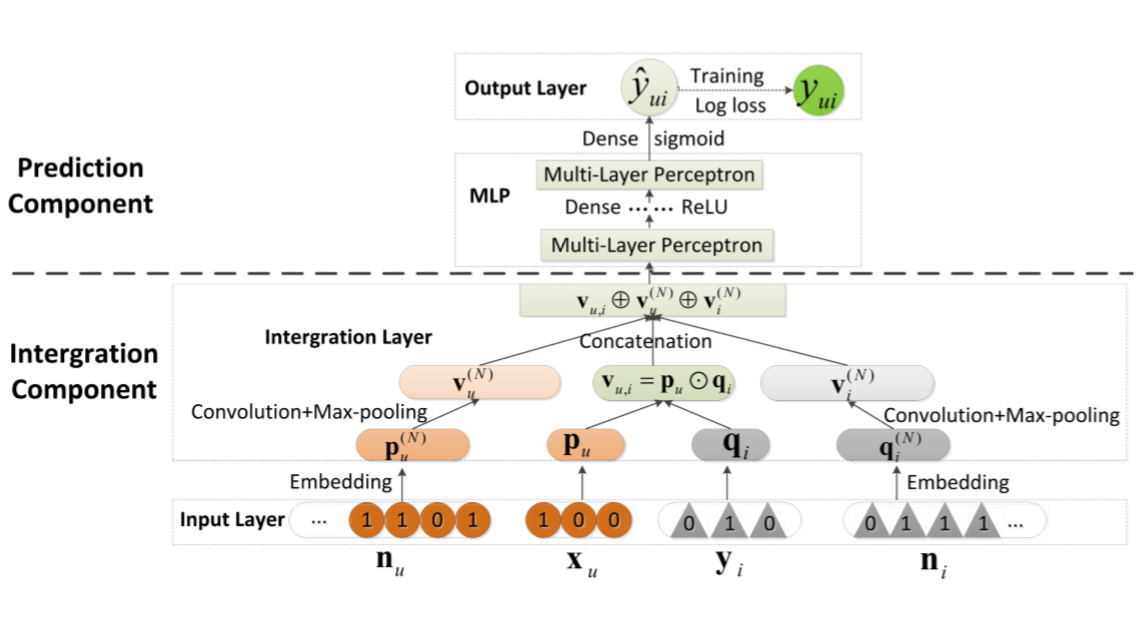NNCF¶
Introduction¶
Title: A Neural Collaborative Filtering Model with Interaction-based Neighborhood
Authors: Ting Bai, Ji-Rong Wen, Jun Zhang, Wayne Xin Zhao
Abstract: Recently, deep neural networks have been widely applied to recommender systems. A representative work is to utilize deep learning for modeling complex user-item interactions. However, similar to traditional latent factor models by factorizing user-item interactions, they tend to be ineffective to capture localized information. Localized information, such as neighborhood, is important to recommender systems in complementing the user-item interaction data. Based on this consideration, we propose a novel Neighborhood-based Neural Collaborative Filtering model (NNCF). To the best of our knowledge, it is the first time that the neighborhood information is integrated into the neural collaborative filtering methods. Extensive experiments on three real-world datasets demonstrate the effectiveness of our model for the implicit recommendation task.

Running with RecBole¶
Model Hyper-Parameters:
ui_embedding_size (int): The embedding size of user and item. Defaluts to64.neigh_embedding_size (int): The embedding size of neighborhood information. Defaults to64.num_conv_kernel (int): The number of kernels in convolution layer. Defaults to128.conv_kernel_size (int): The size of kernel in convolution layer. Defaults to5.pool_kernel_size (int): The size of kernel in pooling layer. Defaults to5.mlp_hidden_size (list): The hidden size of each layer in MLP, the length of list is equal to the number of layers. Defaults to[128,64,32,16].neigh_num (int): The number of neighbors we choose. Defaults to20.dropout (float): The dropout rate in MLP layers. Defaults to0.5.resolution (float): The parameter in louvain algorithm, which decides the size of the community. Defaults to1.0.use_random (bool): Whether to use random method to train neighborhood embedding. Defaults toTrue.use_knn (bool): Whether to use knn method to train neighborhood embedding. Defaults toFalse.use_louvain (bool): Whether to use louvain method to train neighborhood embedding. Defaults toFalse.
A Running Example:
Write the following code to a python file, such as run.py
from recbole.quick_start import run_recbole
run_recbole(model='NNCF', dataset='ml-100k')
And then:
python run.py
Tuning Hyper Parameters¶
If you want to use HyperTuning to tune hyper parameters of this model, you can copy the following settings and name it as hyper.test.
learning_rate choice [0.0005,0.0001,0.00005]
neigh_embedding_size choice [64,32]
mlp_hidden_size choice ['[128,64,32,16]','[64,32,16,8]']
num_conv_kernel choice [128,64]
Note that we just provide these hyper parameter ranges for reference only, and we can not guarantee that they are the optimal range of this model.
Then, with the source code of RecBole (you can download it from GitHub), you can run the run_hyper.py to tuning:
python run_hyper.py --model=[model_name] --dataset=[dataset_name] --config_files=[config_files_path] --params_file=hyper.test
For more details about Parameter Tuning, refer to Parameter Tuning.
If you want to change parameters, dataset or evaluation settings, take a look at